Practical tips for using the London red buses.
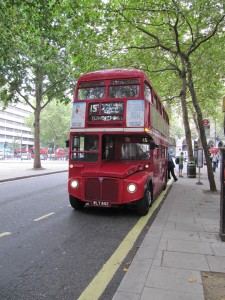 London Buses are some of the classic icons of these wonderful city, like the black cabs and the red phone boxes. They are also a very convenient way to explore the city, even more than the tube. Also, if you take a place on the upper deck you can enjoy a wonderful view. And don’t forget that if you use only buses and you have an oyster card, the daily cap is only £4.40, much less than the daily limit of £7.00 for the tube (only within zones 1-2, otherwise is more expensive). Basically, after only 3 bus rides you can travel around for the rest of the day for free. Great, isn’t it?
London Buses are some of the classic icons of these wonderful city, like the black cabs and the red phone boxes. They are also a very convenient way to explore the city, even more than the tube. Also, if you take a place on the upper deck you can enjoy a wonderful view. And don’t forget that if you use only buses and you have an oyster card, the daily cap is only £4.40, much less than the daily limit of £7.00 for the tube (only within zones 1-2, otherwise is more expensive). Basically, after only 3 bus rides you can travel around for the rest of the day for free. Great, isn’t it?
Another advantage of travelling by bus is that any corner of London can be easily reached and during the journey you can enjoy the view, rather than being closed inside an underground carriage.
If you think about the huge cost of the hop-on-hop-off open top tourist buses, you realize how conveninet travelling by red bus can be. Many times you will meet a tourist bus sharing exactly the same route. On a London bus you will miss the story and the explanations that you get from a tourist guide, but for that you can rely on us!
How to use the London bus map.
How do you use the double decker buses and how do you find your way in London? This blog was born also to help you using the red buses and to give you suggestions to enjoy this wonderful city. You just need to follow a few tips.
Learn to read a general bus map: the Transport For London website has prepared one with all the major attractions and the bus lines that will take you there. Here is a copy.
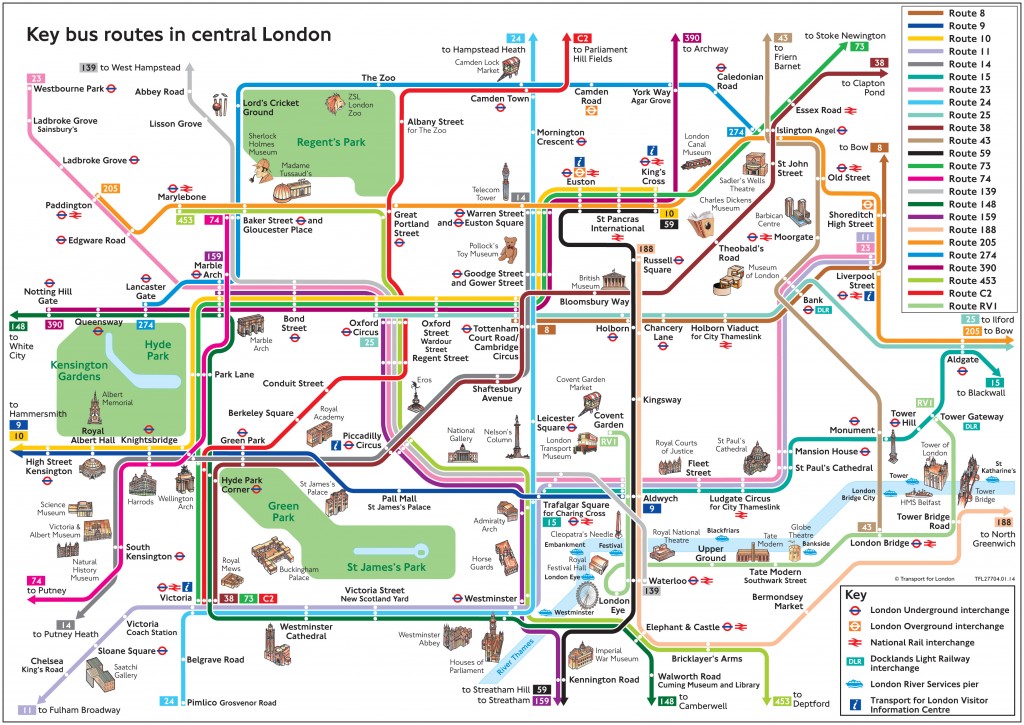
The map might seem complicated at first sight, but it’s actually very easy to use. Let’s make an example. Suppose you find yourself near Westminster Abbey (that you can find in the lower part of the map) and you want to go to Harrods (on the left). On the map we can see that only three buses go towards the left of the map from Westminster: the bus 24(light blue line), 11 (violet) and 148 (green). The first two bus routes don’t take you anywhere near Harrods, but if you follow the green line showing the route of the 148 you can see that after Victoria it turns north and gets to Hyde Park Corner, where it meets several other bus routes. Four of them goes towards the left of the map (West) and goes near Harrods: the bus routes 74 (purple line), 14 (grey), 9 (blue) and 10(yellow). So, from Westminster we can take the bus 148 to Hyde Park Corner, where we can change bus and take one that will take us to Knightsbridge, the closest bus stop to Harrods.
How to read the indications at the bus stops.
Now that we know the itinerary we have to follow, we have to find out where we can get the bus 148. On which side of the road? And where is the bus stop? The tables that are displayed at any bus stop become useful. Let’s take a look at one for our example.
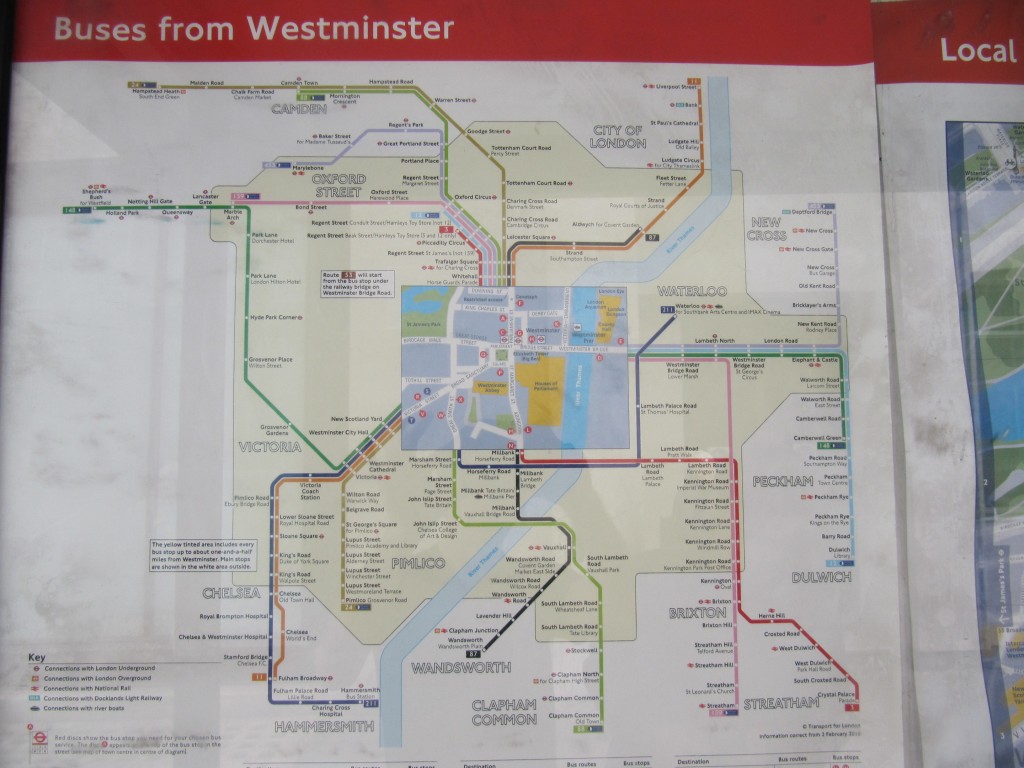
The map told us that we have to take the bus 148; on this table we can see that the bus going to Hyde Park Corner (our first stop of our journey to Harrods) has “Shepherd’s Bush” as final destination. On the other part of the table we can see where the bus stop of the 148 to Shepherd’s Bush is. The table says that the 148 to Shepherd’s Bush can be taken at three bus stops: D, P and V. On the previous image you can see the locations of these bus stops. If we are near the main entrance of Westmnster Abbey, the nearest bus stop is P. Now we only have to go to the bus stop P and take the bus 148 and get off the bus at Hyde Park Corner (the bus stops are announced before you get there). There we will find at the bus stop a similar table which will tell us where we can take one of the four buses (9, 10, 14 or 74) towards Knightsbridge.
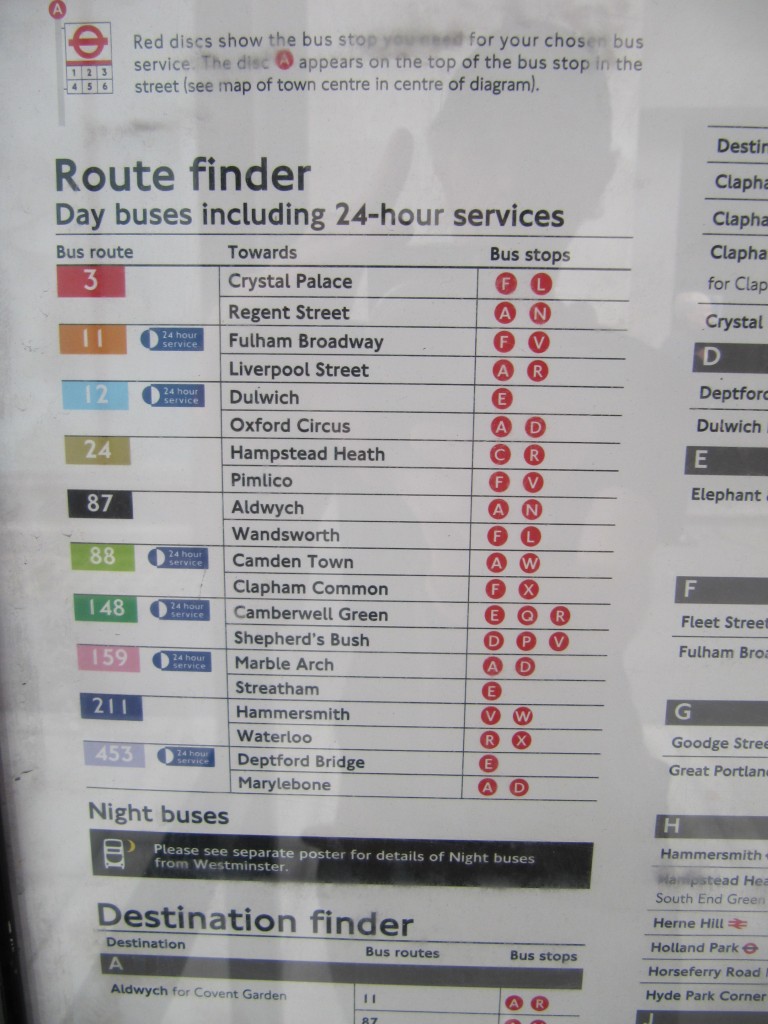
The first time it might seem a bit complicated, but, in many cases, you will need just one bus to get to your destination. Also, the bus stops where you can get alternative routes are always the same, whatever your final destination is: Hyde Park Corner, Marble Arch, Oxford Circus, Piccadlly Circus, Trafalgar Square and Westminster. A small piece of advice: if you learn the position of the bus stops around Trafalgar Square and Piccadilly Circus you will be able to get a bus to almost every destination.
If you follow these two instructions (the bus map with all the attractions and how to read the information at the bus stops), rest assured that your trip will be easy and you can relax and enjoy the landscape
Did you know? When you use your oyster card (or your contactless card) you have to touch it only once on the yellow reader located near the bus driver; you don’t need to touch again when you get off the bus, because you are charged per bus rides, and not by distance.
You can build your own itineraries, or you can follow ours. Our itineraries will clearly tell you which bus you need to take, where to take it and where to get off. However, if you make any mistake, you can always get out at the following bus stop, cross the road and come back from the opposite side.
You can also take a bus at random and let it take you through the streets of London, as they come.
If you learn to use the London red buses, you will never regret it, and the city will be a little be more yours.
Do you have any experience with the London Buses? Do you need any advice or suggestion? Leave your comments!
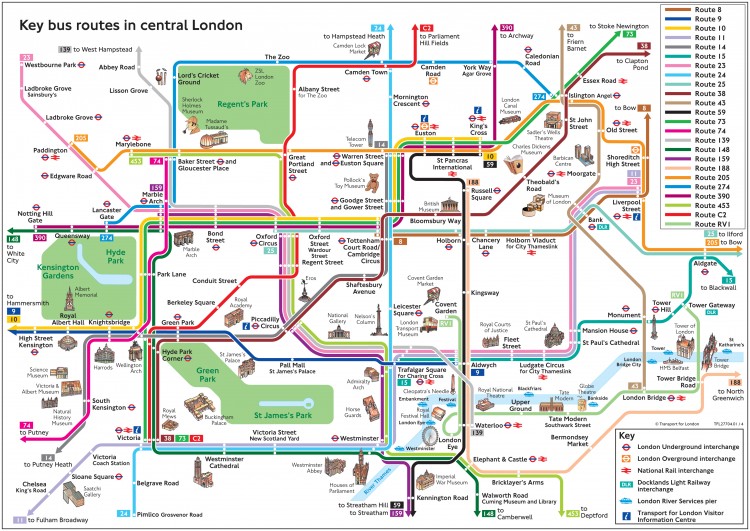
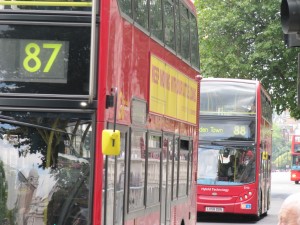
Thank you for taking the time to share this information. It’s very helpful!
Thank you Debi. And if you need more info or suggestions keep on following us!
Hello
Can you tell me the number of the bus from collingham road (not far gloucester road) to go to buckingham Palace
Thank you for you informations
Hi!
It’s the bus 74, in front of Sainsbury’s (bus stop GJ) direction Baker Street. Get off at Hilton Hotel. Then cross Green Park on foot. No bus takes you directly to Buckingham Palace